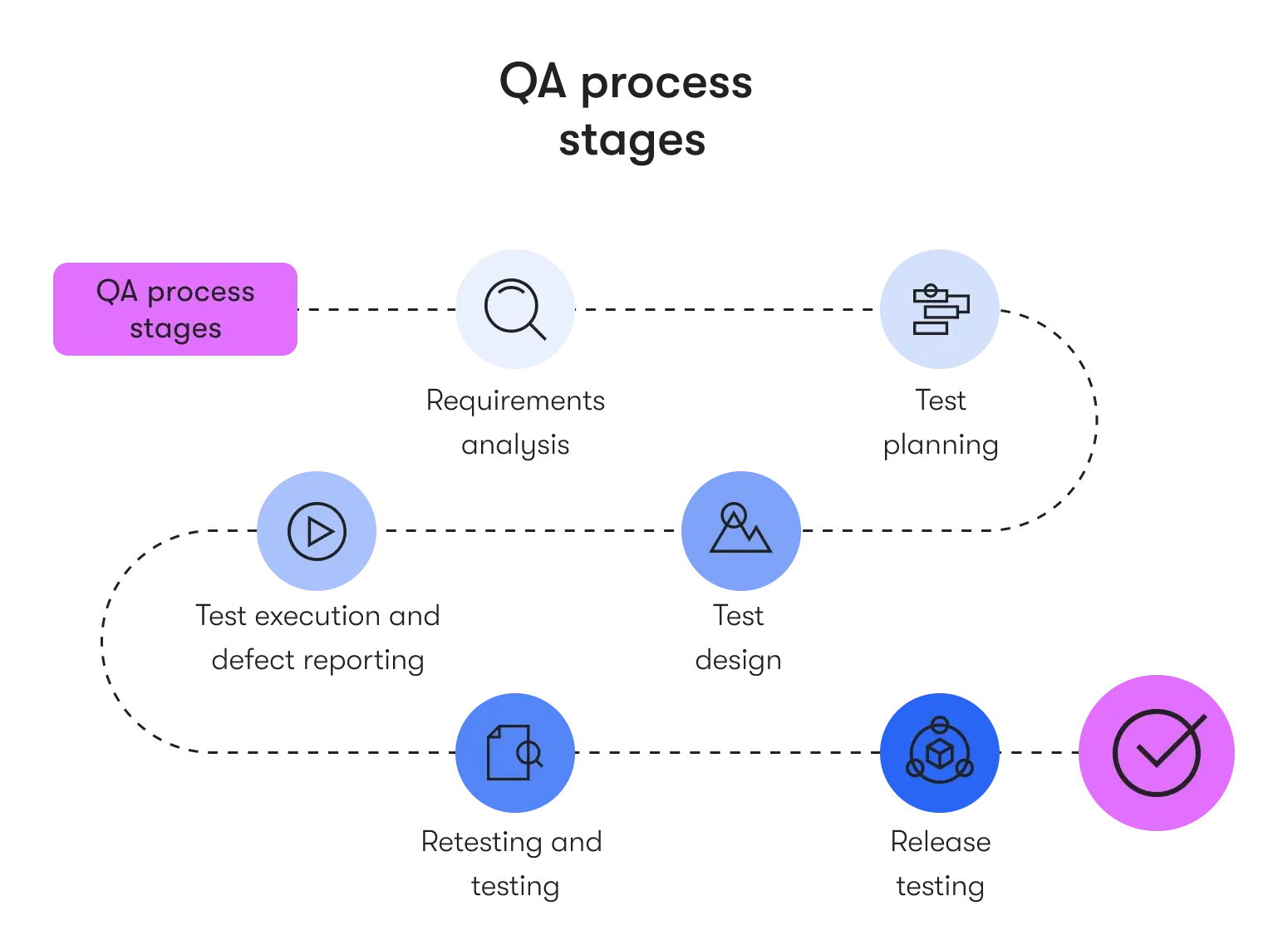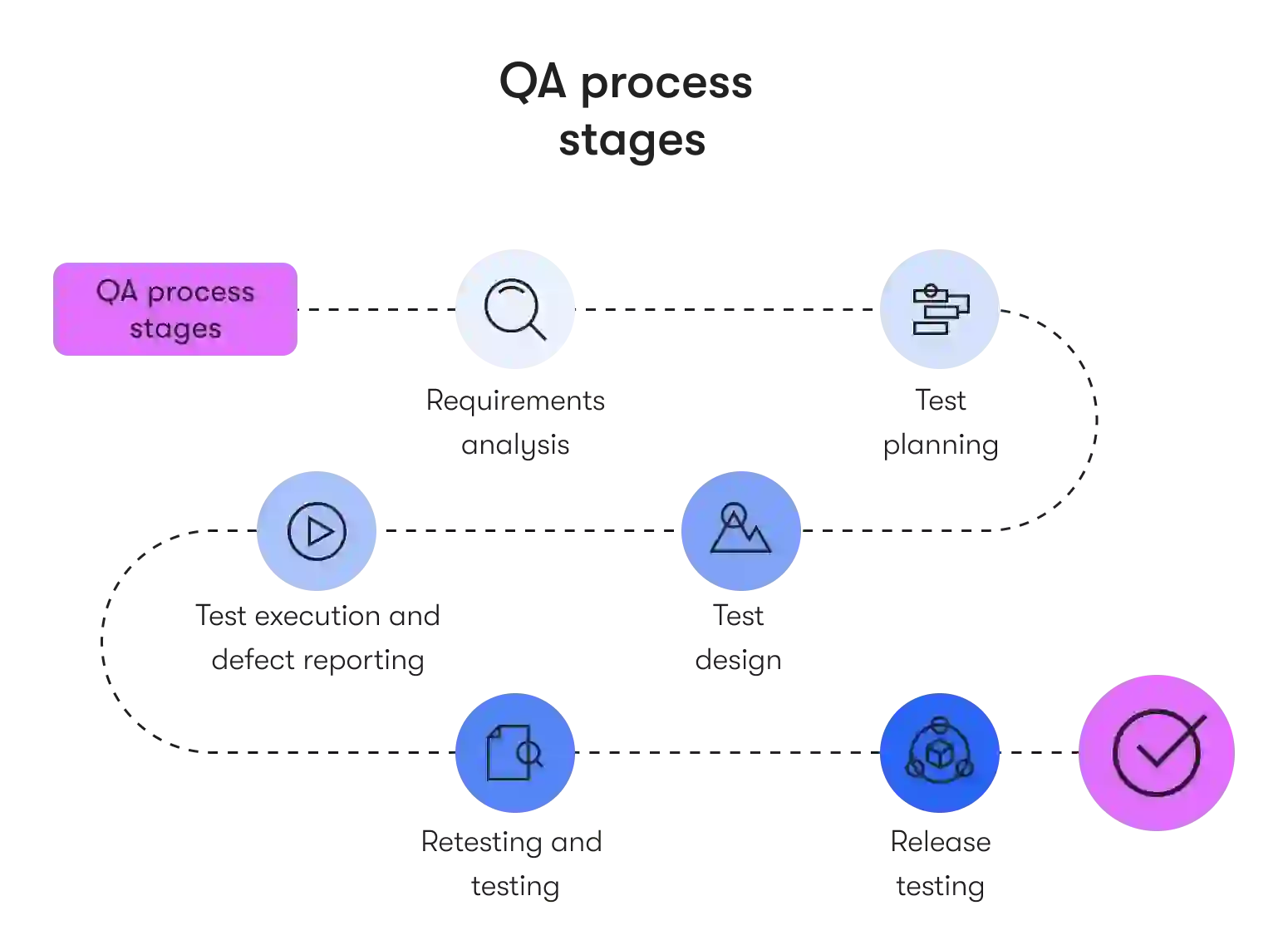The quality assurance (QA) process ensures the quality and caliber of your products. Without testing controls, end-product outcomes can suffer. That’s why you need a high-quality testing process as bad QA tactics will distort any final release with a host of bugs and half-completed updates.
To avoid such common pitfalls you need high-quality QA embedded directly into your development cycle. Let’s explore testing and improving QA and the steps you can take towards QA process improvement.
What is the QA process?
The QA process is a series of testing activities that confirm each product achieves standard quality metrics. Quality metrics are determined based on company goals, consumer expectations, and internal stakeholder demands. A series of tests discover and identify any defects that could threaten the end value of a product.
Ideally, the QA process occurs from the start of the software development life cycle. This ensures that all discovered defects are resolved before the product releases to market.
What does the QA process look like?
A normal QA process follows a structured activity sequence. Most activities occur according to a standard testing plan that maps out software test execution throughout the development lifecycle:
- Planning and requirement analysis: First, define all objectives and standards. The test plan should match all project requirements and ensure each specification is testable. Design all quality gates to align with predetermined quality metrics.
- Test design: Second, create the test scenarios. Determine how you will test the various aspects of the project. Be sure to build test environments that match production values as much as possible.
- Test execution: Third, run all test scripts and test cases. Collect data and evaluate all functionality.
- Review and retest: Fourth, report any located bugs with detailed descriptions of how to reproduce the defect. Once the defects resolve, re-run all test cases to ensure new updates have not altered functionality.
- Release testing: Upon several review cycles and updates from numerous sources of feedback, ensure there are no critical defects. If the product achieves all quality assurance metrics, deploy. Upon release, continue monitoring to improve upon any post-release issues.

Why is it important to make the QA process optimized?
The QA process operates as a control measure. Without clear precaution limits, the quality of all work can suffer. It is a manner of risk reduction. To that end, the end product relies on the strength of your controls.
A well-optimized QA process also delivers you plenty of benefits:
- Better product quality: Robust testing rectifies defects that may have passed inspection environments built with less strict controls. Higher software quality with fewer bugs results in more reliable and stable products.
- Enhanced customer satisfaction: High-quality QA ensures consumers receive a seamless, bug-free experience. It is a proactive approach to testing that achieves greater levels of consumer satisfaction.
- Cost reductions: Good testing catches problems earlier in the development process, which costs far less than fixes and maintenance made post-release.
- Accelerated development: Early problem identification results in fewer defects and a faster release timeline.
- Confidence and morale: Rigorous assurance testing builds trust, not only from consumers but all employees and stakeholders. Job satisfaction, retention, and loyalty are likely by-products of such morale improvements.
- Continuous improvement: An optimized QA process regularly enhances all development processes (including its own). That drives innovation and lets you stay “ahead of the curve”, especially in regard to security and compliance updates.
CAPTURE THESE BENEFITS WITH OUR QA ENGINEERS
Connect with the experts at EPAM Startups & SMBs to discover more about our testing solution services.
9 steps to improve your QA process
There are numerous quality assurance improvement ideas. Here are nine possible steps on how to improve the QA process.
Step 1: Define clear objectives
Provide cohesion by outlining your goals. QA engineers need to know what you hope to achieve. Plus, you can create far more employee buy-in when you note how the QA process aligns with your organization's trajectory and future accomplishments.
Be sure to use granular detail. Describe your approach to topics such as coding standards, QA best practices, and testing methodologies.
Step 2: Establish communication and reporting practices
Outline all documentation and communication channels. Developer teams, the QA outsourcing provider, QA engineers, project management staff, and all stakeholders should have numerous opportunities to initiate contact. For example, that means you need to establish standard formats for reporting so that everyone can stay on the same page as testing occurs. If developers and QA testers cannot legibly understand reports correctly, your QA process will cause more harm than good.
Step 3: Shift left
Emphasize collaboration. That means including QA teams from project inception. All testing processes should begin at the start of the software development lifecycle, which is known as shift-left testing. Test early and consistently to help lower costs and maintain a smooth project pipeline.
Step 4: Automate where possible
Invest in tools that automate the QA process, such as generative AI for testing. Automation offers the immediate benefit of cost optimization by eliminating manual labor. It also includes several secondary benefits such as increased test coverage, a faster QA cycle, and low-cost repeatable testing. It is a well known tip: automate whenever possible.
Step 5: Develop test planning strategies
QA departments need their own planning guidelines, not just overall considerations for the project pipeline. A test plan should outline how testing itself occurs across all testing phases.
- Regression: Regression testing confirms that new changes have not altered previous functionality. Define the success metrics for one of the most important testing phases.
- Performance: Set baseline measures for load testing within critical user scenarios. Have all performance tests mirror real-world scenarios. Ensure functionality even as loads scale.
- Security: Engage in security testing across all attack vectors (e.g. vulnerabilities in static code). When possible, engage in data protection tests (authentication, authorization), penetration testing, compliance testing, and dependency scans.
- User Acceptance Testing (UAT): Set up usability test scripts that cover the numerous scenarios a customer may experience. Pay attention to usability and incorporate robust feedback mechanisms to help with exploratory testing.
Step 6: Measure and update success metrics
Even with the most comprehensive testing strategy, you will notice deficiencies. Reality does not always fit expectations. After you have significant report data, look for bottlenecks or issues that deserve focus. Assess the efficacy of your QA process on details such as test coverage and execution times. Adjust according to your business mission.
Step 7: Implement knowledge transfers and feedback
As the project progresses, install feedback loops. Internal employees will have diverse perspectives that are critical for quality assurance process improvement. Collect as much information from as many departments as possible to help discover key issues within QA.
Take note: feedback loops only occur if you have open lines of communication. Ensure that everyone has access to all test plans, reports, and results.
Step 8: Monitor and audit
Monitoring and maintenance do not end. You will need to complete regular compliance checklists, especially as regulatory bodies evolve. Audit trails are necessary. Real-time alerts will also ensure product reliability for all stakeholders.
Step 9: Continuously improve
Repeat these suggestions over and over again. Lessons learned from initial iterations offer valuable ways to improve your project pipeline and its integrated assurance process. Improve the levels needed to surpass quality gates, aggressively train employees, and take action upon peer reviews. It is a never-ending process that consistently raises the standard of your testing and, by extension, product quality.
TAKE YOUR QUALITY ASSURANCE TO THE NEXT LEVEL
We have QA consultants and engineers in all key testing areas to help you.
5 tools to help you improve your QA process
Since the software development landscape is complex, there are numerous tools you can use. Each tool applies to specific testing process needs that different companies or industries may face. From test management to code review and bug tracking, there are hundreds of solutions available. To help you get started, here are five common and popular tools used by QA engineers:
- TestRail: TestRail is a test execution tool. It is a useful tracking solution for test progression and test data.
- Selenium: Selenium is a popular open-source testing application. It automates testing for web applications.
- Gatling: Gatling is a performance testing tool. Used primarily for continuous load testing, it also includes bug tracking and test project management features.
- Jira: Jira is a defect-tracking tool designed for projects that adhere to the Agile methodology. CI/CD integrations offer a comprehensive multi-purpose solution, but it is known for its issue management.
- Sonarqube: Sonarqube is a code inspection tool. It performs automated analysis to detect and clean any code defects.
How we improve QA process with our best practices
At EPAM Startups & SMBs, we use a variety of techniques to improve quality assurance processes for all our clients. The two following case studies exemplify our approach:
Case 1: QA improvement for an insurance software provider
- Task: Improve the productivity of the testing process for a major Insurance Software company — without a drastic increase in costs as the business scales.
- Challenge: Introduce automation and regression testing across both client and server operating systems
- Results: Upon successful integration, we carried out 3,000 end-to-end tests and achieved a 50% reduction in manual processes. The client enjoyed more than five years of stable development with superior software quality.
Case 2: QA improvement for an information services enterprise
- Task: Modernize the testing cycle of a data packet processing company. The client supplies the data packets to end-user consumers and thus needs reliable and rapid delivery.
- Challenge: Achieve three-level test coverage metrics in addition to accelerating standard regression processes and modernizing test structures.
- Results: 1,700 completed UI tests and 400 for web applications. The client earned a reduction in manual testing by 70%.
READY TO OPTIMIZE YOUR QA TESTING PROCESSES?
Contact us to discuss our suite of testing products and quality assurance improvement services.
Conclusion
An improved QA process translates into an improved software development life cycle. Any investment into your testing strategy ensures a high standard of end-product quality. That brings with it faster times to market, cost reductions, and enhanced customer satisfaction.
However, improving QA is a complex task. If you are struggling, reach out to the experts. A technical partner can provide the knowledge and know-how to immediately update outdated processes. If you want to get started, contact us to learn more about our QA consulting services.
FAQ

Expert digital communicator and editor providing insights and research-based guides for technology buyers globally.
Expert digital communicator and editor providing insights and research-based guides for technology buyers globally.
Explore our Editorial Policy to learn more about our standards for content creation.
read more


















